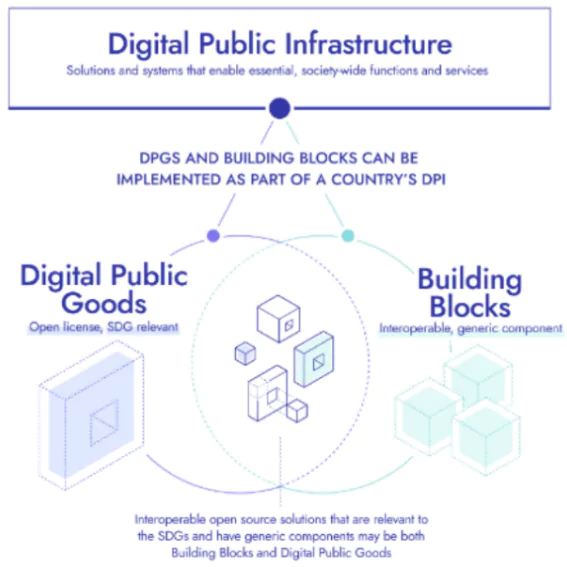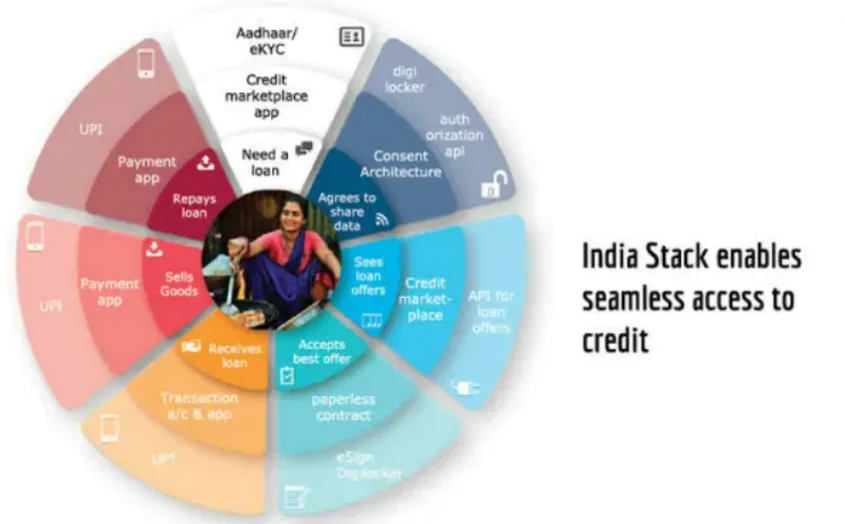India has positioned digital public infrastructure (DPI) as a technology-enabled instrument for inclusive and sustainable development.
About Digital Public Infrastructure (DPI)

- DPI refers to the digital platforms and systems that enable the delivery of public services, such as identification, payments, health, education, and governance.
- It can be understood as an intermediate layer in the digital ecosystem.
- It sits atop a physical layer (including connectivity, devices, servers, data centers, routers, etc.), and supports an apps layer (information solutions to different verticals, e-commerce, cash transfers, remote education, telehealth, etc.).
- DPI can help solve global challenges such as poverty reduction, climate resilience, and digital transformation by improving the efficiency, transparency, inclusion, and innovation of public service delivery.
- Three Pillars of DPI– DPI has 3 broad objectives- identity, payments and data management.
- India, through its India Stack Platform, has become the first country to develop all the three foundational pillars of DPI.
Enroll now for UPSC Online Course
| DPI objective |
DPI Pillar |
India’s DPI pillars name |
| Identity |
Digital ID System |
Aadhar |
| Payment |
Real-time fast payment system |
UPI |
| Data Management |
Consent-based data sharing system |
Data Empowerment Protection Architecture (DEPA) |
- Categories of DPI: DPIs can be broadly grouped into two categories:
-
- Foundational DPIs: Aadhaar, UPI, and Data Empowerment and Protection Architecture (DEPA) are developed to create robust digital rails and span the domains of digital identity systems and payment infrastructure, and data exchange platforms.
- Sectoral DPIs: It provides specialized services tailored to the needs of specific sectors.
- Examples include the Ayushman Bharat Digital Mission, which is the rails for the provision of universal health coverage.
- A notable DPI success story is the CoWIN platform, which utilized Aadhaar-based authentication to facilitate the administration of more than 2.2 billion Covid-19 vaccines.
About India Stack:
- It is a set of APIs that allows governments, businesses, startups and developers to utilise unique digital Infrastructure to solve India’s hard problems towards presence-less, paperless, and cashless service delivery.
- India Stack consists of three layers of open APIs: identity, payments, and data.
|
India and Digital Public Infrastructure (DPI)
- India, through India Stack, became the first country to develop all three foundational DPIs through JAM Trinity Initiative (JAM stands for Jan Dhan Yojana, Aadhaar and Mobile number):
- Jan-Dhan Accounts ensure access to various financial services like availability of basic savings bank account, access to need based credit, remittances facility, insurance and pension to the excluded sections i.e. weaker sections & low income groups.
- Real-time fast payment: India ranks 1 for Real-time payments globally, with 89.5 Bn payment transactions in 2022 (76.8% YoY growth (2021-2022)).
- Digital identity (Aadhar): Till date, 1.3+ Bn Aadhaar cards have been issued and 15 Bn Aadhaar based E-KYC verification has been done.
- Platform to safely share personal data: BHIM-UPI has emerged as the preferred payment method among users.
- UPI has set a new record of processing over 9 Bn transactions (worth $ 179 Bn) in May ’23 .
- UPI accounts for 75% of the total retail digital payments in India.
Check Out UPSC CSE Books From PW Store
About Digital India Mission
- It is a flagship program of the Government of India that aims to transform the country into a digitally empowered society and knowledge economy.
- The mission focuses on three key areas – digital infrastructure as a utility to every citizen, governance and services on demand, and digital empowerment of citizens.
|
Significance of DPI
- Scalability: DPIs enable large-scale participation, evidenced by India’s over 1.3 billion Aadhaar enrolments and more than 10 billion UPI transactions monthly, showcasing their capability to handle vast numbers.
- Platform Role: DPIs serve as foundational platforms that allow seamless integration and interaction for building digital applications and services , enhancing overall functionality.
- Public-Private Collaboration: They encourage innovation through public-private partnerships, fostering rapid development and value creation by leveraging the infrastructure.
- Network Effects: As multi-sided platforms, DPIs benefit from network effects, where the value on one side (e.g., users) increases with the growth of participants on the other side (e.g., services), driving exponential utility.
 Innovation: DPI can foster innovation and collaboration across sectors and countries, by creating a common platform for data exchange, interoperability, and reuse.
Innovation: DPI can foster innovation and collaboration across sectors and countries, by creating a common platform for data exchange, interoperability, and reuse. -
- Account Aggregator framework enables consent-based data sharing among financial service providers, enhancing consumer choice and convenience .
- Sustainable Development Goals: DPI can support the achievement of the SDGs, by addressing urgent challenges such as poverty reduction, climate resilience, and digital transformation.
- The National Digital Health Mission (NDHM) aims to enhance healthcare access, affordability, and quality, supporting SDG-03 to ensure healthy lives and well-being for all.
- Economic Growth: A recent report led by Nasscom indicated that DPIs could propel India towards an $8 trillion economy by 2030, a monumental step towards achieving the country’s ambitious $1 trillion digital economy target.
- Global Leadership In DPI: India launched the “One Future Alliance (OFA)” initiative during the G-20 summit, aimed at fostering collaboration in DPI for global digital growth, thus taking global leadership.
One Future Alliance:
- India floated a concept of ‘One Future Alliance’, a voluntary initiative that aims to bring together all countries and stakeholders to synergise, shape, architect and design the future of DPIs that can be used by all.
- Under the proposed alliance, India will work with other countries to create a global framework for cybersecurity principles and laws.
|
Challenges associated with Digital Public Infrastructures (DPIs) include
- Market Concentration: DPIs can foster monopolies or oligopolies, where a few dominant players capture most of the market.
- Example, UPI payment system has resulted in a duopoly, limiting competition and potentially stifling smaller players from entering the market.
- Data Exploitation: Firms operating within DPIs can collect and leverage vast amounts of user data to expand into related sectors, such as retail lending.
- This unchecked access to data creates an unfair competitive advantage, raising concerns about the balance between innovation and anti-competitive practices.
- Regulatory Gaps: The absence of comprehensive regulatory frameworks around DPIs poses significant risks to data privacy, security, and system interoperability. Without clear rules and governance, DPIs can be exploited by private firms,
- Innovation Concerns: Government-supported DPIs might unintentionally entrench private entities without sufficient regulatory oversight.
- Privatisation Risks: The involvement of private firms in DPIs raises concerns about the privatisation of public data and the absence of clear frameworks for risk-reward sharing.
- The lack of contractual or regulatory oversight can result in public data being exploited for private gain.
- Cyber-Attack: DPI is vulnerable to cyber-attacks and data breaches that compromise sensitive data and transactions.
- Between June, 2018 and March, 2022, India’s banks recorded 248 successful data breaches by hackers and criminals.
- Digital Inequality: India has a digital divide where many lack access to digital infrastructure such as smartphones and internet connectivity, particularly in rural areas.
- Infrastructure: One of the biggest challenges is the lack of proper infrastructure, including internet connectivity, electricity, and hardware.
Check Out UPSC NCERT Textbooks From PW Store
Key Global Practices that India can learn
Ethiopia
- Modular Infrastructure (FarmStack): Ethiopia’s FarmStack uses open, interoperable DPI for agriculture, aligned with national strategies like Digital Ethiopia and SDGs.
- Strategic Roadmaps: Ethiopia’s clear FarmStack roadmap aligns DPI with national priorities, offering a model for strategic DPI planning.
Estonia
- Institutional Ownership (X-tee): Estonia’s X-tee highlights strong institutional frameworks for governing and operating DPI.
- Privacy and Data Protection: Estonia’s laws emphasise data privacy and security, ensuring trust in digital systems.
- Multi-Stakeholder Collaboration: Estonia’s DPI integrates government, private sector, and regulators, showcasing the value of partnerships for scaling DPI.
|
Way forward
- Clear Role Delineation: There is a need to clearly define the roles and responsibilities of both public and private entities involved in DPIs. This ensures accountability and transparency, especially given the scale and complexity of these systems.
- Governance Frameworks: Governance models need to be governed akin to Model Concession Agreements used in infrastructure projects like highways and ports.
- These frameworks can offer structured oversight for public-private partnerships in DPIs, ensuring that the public interest is safeguarded.
- Techno-Legal Balance: There is a need to implement a robust system of checks and balances that protects public interest without hampering private innovation.
- Soft Law Instruments: Soft law guidelines should be employed, which focuses on encouraging industry best practices rather than enforcing rigid rules. These could include principles such as data encryption, access control, and mandatory user consent for data usage
- Segmented Governance: There is a need to adopt a tailored governance approach by separating DPI elements that require statutory or contractual regulation from those governable through soft law.
- Strengthening Cybersecurity Framework: Strengthen cybersecurity to protect digital assets and prevent cyber attacks on important information like Aadhaar and banking data.
- Improve Digital Literacy: To enable citizens to fully utilize digital services and platforms, as many are unaware of their benefits or lack the necessary skills to access and use them.
Enroll now for UPSC Online Classes
Conclusion
Digital Public Infrastructure (DPI) has revolutionised service delivery through platforms like Aadhaar, UPI, and CoWIN. While DPIs enhance access and efficiency, challenges like market concentration and data privacy must be addressed. A balanced approach, with clear roles and flexible regulation, can ensure DPIs continue to drive innovation while protecting public interest.
![]() 11 Sep 2024
11 Sep 2024

 Innovation: DPI can foster innovation and collaboration across sectors and countries, by creating a common platform for data exchange, interoperability, and reuse.
Innovation: DPI can foster innovation and collaboration across sectors and countries, by creating a common platform for data exchange, interoperability, and reuse. 